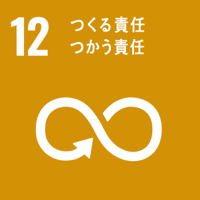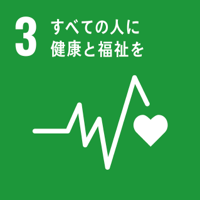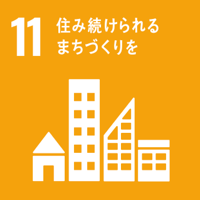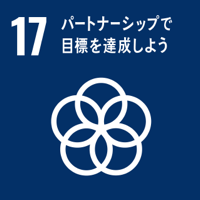Food Design Initiatives
Based on one of our action guidelines, "Provide safe and secure foods" we have established our own food safety policy and hygiene management standards to provide safer and more secure products. Based on the "Explore new possibilities for agricultural products" we will also work on the development of a variety of products to pursue the possibilities of food.
Goals to achieve the SDGs
Priority Issues and Details of Initiatives
| Priority Issues | Details of Initiatives |
|---|---|
| ①Provide safe and secure foods | Maintain FSSC 22000 certification. Reduction in the number of claims. |
| ②Pursuit of Food Possibilities. | Development of various products. |
Activities related to provide safe and secure foods
In June 2018, the Food Sanitation Law was revised and "sanitation management in accordance with HACCP" was institutionalized for all businesses in principle. The Nara Plant of Kyoto Grain System Co., Ltd. acquired the international food safety system certification standard "FSSC22000" on January 11, 2012. We have established our own food safety policy and hygiene management standards, and our employees work together every day to provide safer and more reliable products.
About FSSC22000
FSSC22000 is a food safety standard adopted by the Global Food Safety Initiative (GFSI), an international federation of food manufacturers and distributors, and covers a scope that cannot be covered by the ISO22000 food safety management system standard.
For example, ISO 22000 clearly defines the "prerequisite program" items that form the basis of food safety, but leaves the specific details of the program to each company.
As a result, there are differences in the approach to the rules among companies, and there are companies with good sanitation management and companies with poor sanitation management. FSSC22000 compensates for these problems.
Main features of FSSC22000
- Interactive communication
Food safety is defined as "the joint responsibility of all parties involved in the food chain" and requires that those involved in the food industry share reliable information.
- Management Systems
In order to implement food safety measures not only at food production sites but also throughout the entire organization, including management, it is important not only to create rules and management regulations but also to create a system for "how employees can operate them.
- HACCP Principles
In order to perform necessary control where it is really needed, we do not perform the same hazard control for all processes, but separate those that are especially important and those that are managed on a daily basis.
If significant controls are required, control standards will be established in accordance with HACCP12 procedures.
Furthermore, we will return to the "starting point" of HACCP and conduct more detailed management, taking into consideration "how we can make food safety more thorough and meet the needs of consumers.
- Prerequisite Programs (PRPs)
The "prerequisite" rules for food sanitation are based on ISO/TS22002-1.
- Food Safety Measures
Food safety matters such as food defense, raw material and allergen control are specifically defined and operated in more detail.
Food safety is defined as "the joint responsibility of all parties involved in the food chain" and requires that those involved in the food industry share reliable information.
In order to implement food safety measures not only at food production sites but also throughout the entire organization, including management, it is important not only to create rules and management regulations but also to create a system for "how employees can operate them.
In order to perform necessary control where it is really needed, we do not perform the same hazard control for all processes, but separate those that are especially important and those that are managed on a daily basis. If significant controls are required, control standards will be established in accordance with HACCP12 procedures. Furthermore, we will return to the "starting point" of HACCP and conduct more detailed management, taking into consideration "how we can make food safety more thorough and meet the needs of consumers.
The "prerequisite" rules for food sanitation are based on ISO/TS22002-1.
Food safety matters such as food defense, raw material and allergen control are specifically defined and operated in more detail.
Kyoto Grain System Co., Ltd. Food Safety Policy
We will continuously improve the effectiveness of our food safety management system in order to provide safe and reliable products.
We will comply with all relevant laws, regulations, and food safety customer requirements, and maintain conformity with food safety management system standard requirements.
In order to meet the needs and expectations of our customers, we establish and maintain effective communication throughout the food chain, including both internal and external parties, to provide "high quality" products that can be used immediately by our users.
Together with our customers, we will create unlimited possibilities for agricultural products.
Based on the food safety policy, we will establish food safety targets and make company-wide efforts to achieve them.
Hygiene Management
We have established our own strict hygiene control standards consisting of 12 items, which we adhere to. We have strict hygiene controls in all programs from procurement, production, shipping, and utilities, including raw materials and products, as well as waste, buildings, and workplace layout.
Measures to Prevent Foreign Material Contamination
1
Entrance management
At the entrance to the factory, we have a changing room. In that place, we change clothes to work clothes, hand wash and disinfect.
In addition, a record of "name, entry/exit time, items brought in, physical condition report, etc." is kept.
When entering the factory, adhesive rollers and installed air showers prevent the entry of dust, dirt, hair, and other small foreign objects.
The above information is not only for our employees, but for all visitors, including our customers.
2
Management of items brought in
A list of items to be brought into the factory (list of prohibited and permitted items) is prepared, and an application is made for the items and number of items when entering and leaving the factory.
In addition, items used in the plant are those that are unlikely to be mixed into products.(Ex; knock-off markers without caps)
Stationery and other items used in the factory are marked with a storage location for each line, and the number of items is controlled.
3
Efforts on Hazard Analysis
Hazard analysis is conducted for each line, and "tolerance levels" are set for each hazard.These contents are made visible through documenting them.
In addition, our food safety team confirms and reviews the operational status at the verification activity meeting.
4
Installation of surveillance cameras and alarm systems
Chain gates are installed at the entrances and exits to the factory premises, surveillance cameras are installed inside the factory, and an alarm system has been installed.
The color of the helmets is also identified for each section and visitor to make it easier for surrounding workers to pay attention to their actions.
1
Entrance management
At the entrance to the factory, we have a changing room. In that place, we change clothes to work clothes, hand wash and disinfect. In addition, a record of "name, entry/exit time, items brought in, physical condition report, etc." is kept. When entering the factory, adhesive rollers and installed air showers prevent the entry of dust, dirt, hair, and other small foreign objects. The above information is not only for our employees, but for all visitors, including our customers.
2
Management of items brought in
A list of items to be brought into the factory (list of prohibited and permitted items) is prepared, and an application is made for the items and number of items when entering and leaving the factory. In addition, items used in the plant are those that are unlikely to be mixed into products.(Ex; knock-off markers without caps) Stationery and other items used in the factory are marked with a storage location for each line, and the number of items is controlled.
3
Efforts on Hazard Analysis
Hazard analysis is conducted for each line, and "tolerance levels" are set for each hazard.These contents are made visible through documenting them. In addition, our food safety team confirms and reviews the operational status at the verification activity meeting.
4
Installation of surveillance cameras and alarm systems
Chain gates are installed at the entrances and exits to the factory premises, surveillance cameras are installed inside the factory, and an alarm system has been installed. The color of the helmets is also identified for each section and visitor to make it easier for surrounding workers to pay attention to their actions.
Control of pests (rodents, insects, etc.) / Allergen control
1
Insect and rodent control
We have contracted with a professional insect control company and are taking measures under the guidance of regular monitoring, patrols, study sessions, etc.
(Ex; installation of various traps, installation of sheet shutters at various locations, sealing of entry routes with caulking, periodic chemical spraying, etc.)
2
Allergen control
We have established and are operating clear rules for allergen control in the factory.For example, a dedicated soybean line has its own entrance and changing rooms.
After allergenic materials are manufactured, the Quality Control Section double-checks (visually and by wiping with a special kit) with the person in charge of the operation to ensure that there are no allergenic residues.
1
Insect and rodent control
We have contracted with a professional insect control company and are taking measures under the guidance of regular monitoring, patrols, study sessions, etc.
(Ex; installation of various traps, installation of sheet shutters at various locations, sealing of entry routes with caulking, periodic chemical spraying, etc.)
2
Allergen control
We have established and are operating clear rules for allergen control in the factory.For example, a dedicated soybean line has its own entrance and changing rooms. After allergenic materials are manufactured, the Quality Control Section double-checks (visually and by wiping with a special kit) with the person in charge of the operation to ensure that there are no allergenic residues.
Traceability system
1
Confirmation upon receipt of raw materials
Receiving staff checks the received raw materials in accordance with our "Raw Materials Receiving Instructions/Survey Sheet".
In addition, raw material samples are taken at the time of receiving cargo and inspected by the Quality Control Section.
2
Retention of records
We retein records of all processes from receiving to manufacturing to shipping, and manage them so that they can be traced within the company.
Records of each process are double-checked by at least two persons and multiple departments.
3
Obtaining information on raw materials, packaging materials, etc.
We strive to obtain information on raw materials such as place of origin, allergens, etc. and safety data sheets (SDS) for purchased raw materials, packaging materials, chemicals, etc.
For some agricultural products, we conduct pesticide residue and radioactivity tests every harvest year to ensure a safe and secure supply of raw materials.
1
Confirmation upon receipt of raw materials
Receiving staff checks the received raw materials in accordance with our "Raw Materials Receiving Instructions/Survey Sheet".
In addition, raw material samples are taken at the time of receiving cargo and inspected by the Quality Control Section.
2
Retention of records
We retein records of all processes from receiving to manufacturing to shipping, and manage them so that they can be traced within the company.
Records of each process are double-checked by at least two persons and multiple departments.
3
Obtaining information on raw materials, packaging materials, etc.
We strive to obtain information on raw materials such as place of origin, allergens, etc. and safety data sheets (SDS) for purchased raw materials, packaging materials, chemicals, etc.
For some agricultural products, we conduct pesticide residue and radioactivity tests every harvest year to ensure a safe and secure supply of raw materials.
Quality control
Product Inspection
Each lot is inspected at the manufacturing site and quality control section based on the specifications of each product.(Inspection frequency varies depending on product standards.)
We support shipments only after the product has passed inspection.
List of analyzers and inspection items
Equipment name
Analysis and Inspection Items
1.Colorimeter
Color tone (L/a/b) [Surface color/Precipitant color/Excipient color]
2.Infrared Moisture Analyzer
Moisture content
3.Near Infrared Analyzer
Protein and moisture content of rice and wheat, etc.
4.Digital Concentration Meter
Brix of the extract
5.Water Activity Analyzers
Water activity
6.Electromagnetic sieve shaker
Particle size distribution of pulverized product
7.Laser Diffraction Particle Size Analyzer
Particle size distribution of powder
8.Microbiological analysis equipment in one form
Viable bacteria
Thermophilic bacteria
Staphylococcus aureus
E.coli
Yeast
lactic-acid bacteria
Product Inspection
Each lot is inspected at the manufacturing site and quality control section based on the specifications of each product.(Inspection frequency varies depending on product standards.) We support shipments only after the product has passed inspection.
List of analyzers and inspection items
| Equipment name | Analysis and Inspection Items |
|---|---|
| 1.Colorimeter | Color tone (L/a/b) [Surface color/Precipitant color/Excipient color] |
| 2.Infrared Moisture Analyzer | Moisture content |
| 3.Near Infrared Analyzer | Protein and moisture content of rice and wheat, etc. |
| 4.Digital Concentration Meter | Brix of the extract |
| 5.Water Activity Analyzers | Water activity |
| 6.Electromagnetic sieve shaker | Particle size distribution of pulverized product |
| 7.Laser Diffraction Particle Size Analyzer | Particle size distribution of powder |
| 8.Microbiological analysis equipment in one form |
Viable bacteria Thermophilic bacteria Staphylococcus aureus E.coli Yeast lactic-acid bacteria |
②Activities related to the pursuit of food possibilities
We develop about 200 prototypes/year, including both in-house developed products and products commissioned by other companies. As we continued to develop prototypes, our technical capabilities improved, and we were able to process materials that could not be handled in the past. With the addition of processing facilities (Asahikawa City, Hokkaido / Nagahama City, Shiga), we are actively engaged in processing and product development of locally produced agricultural products with the cooperation of local companies and farmers.
'For more information on prototype development, please refer to OEM section.




